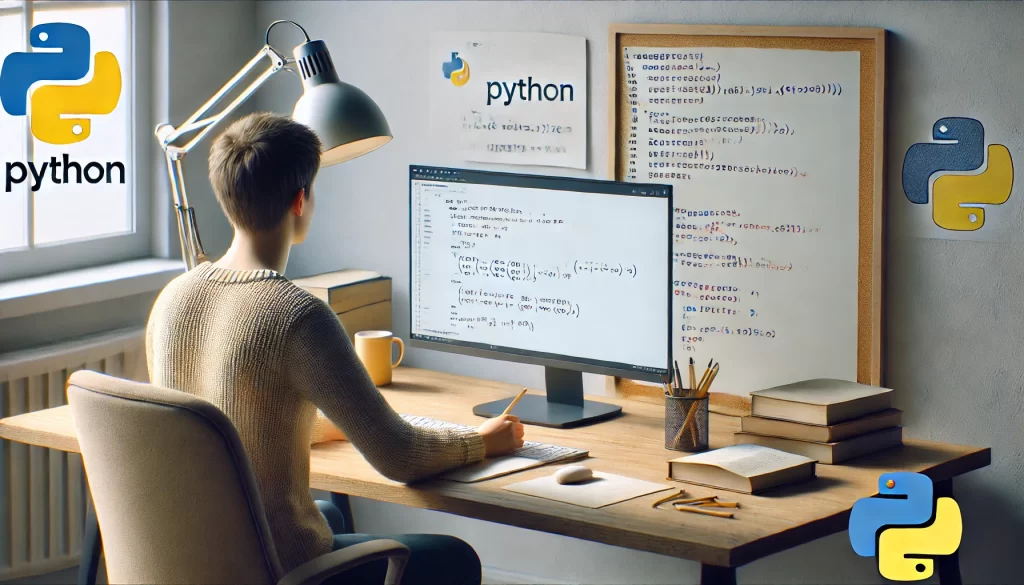Learning data structures and algorithms is essential for anyone aspiring to excel in programming, especially for those working with Python. Python is one of the most popular and user-friendly programming languages, and it provides an excellent platform for understanding these concepts.
Data structures and algorithms are the backbone of writing efficient code, and mastering them will make you a better programmer, improve your problem-solving skills, and open doors to numerous career opportunities.
In this article, we’ll explore how to effectively learn data structures and algorithms in Python, step by step, from the basics to advanced techniques. By the end, you’ll have a roadmap for building a solid foundation and becoming proficient in these crucial areas of programming.
1. Understand the Basics of Data Structures and Algorithms
Before diving into the technical details of data structures and algorithms in Python, it’s important to understand their significance. Data structures are ways of organizing and storing data so that it can be accessed and modified efficiently. Algorithms, on the other hand, are step-by-step procedures for solving problems or performing tasks.
Common data structures include arrays, linked lists, stacks, queues, hash tables, trees, and graphs. Each data structure is designed to store data in a specific way that makes certain operations easier or faster.
Algorithms are designed to perform operations on data structures. They can be simple, like searching or sorting, or more complex, like graph traversal or dynamic programming. Learning how to choose the right data structure and algorithm for a problem is key to writing efficient code.
2. Learn Python Fundamentals
Before tackling data structures and algorithms in Python, you need to be comfortable with the basics of Python programming. If you’re new to Python, start by learning the following fundamental concepts:
- Variables and Data Types: Understand how Python stores different types of data, including integers, floats, strings, and lists.
- Control Structures: Learn how to write loops (for and while loops) and conditionals (if, else, elif) in Python.
- Functions: Master how to define and call functions to organize your code and improve reusability.
- Object-Oriented Programming (OOP): Familiarize yourself with classes and objects, which are important for working with custom data structures.
Once you have a good grasp of Python’s basics, you’ll be ready to explore more complex topics like data structures and algorithms in Python.
3. Start with Basic Data Structures
The first step in mastering data structures and algorithms in Python is to start with the basics. Here are the core data structures you should learn:
Lists (Arrays)
Python’s list is a versatile data structure that can hold a collection of items. Lists are dynamic and can grow or shrink in size as needed. They allow for random access and are great for storing sequences of items.
Learn how to perform common operations on lists such as indexing, slicing, appending, and removing elements. Practice writing algorithms that manipulate lists, such as searching for an element or sorting the list.
Stacks
A stack is a data structure that follows the Last-In-First-Out (LIFO) principle. Elements are added and removed from the top of the stack. Stacks are used in many applications, including parsing expressions and implementing undo mechanisms in software.
In Python, you can implement a stack using lists. Learn how to push (add) and pop (remove) elements from a stack and when to use this data structure.
Queues
Queues follow the First-In-First-Out (FIFO) principle. The first element added to the queue is the first one to be removed. Queues are commonly used in scenarios like task scheduling and managing tasks in a multithreading environment.
In Python, a queue can be implemented using the collections.deque class. Practice adding elements to the back of the queue (enqueue) and removing elements from the front (dequeue). Queues are essential for problems like breadth-first search (BFS) and task scheduling.
Dictionaries (Hash Tables)
A dictionary is a key-value pair data structure in Python that allows for efficient data retrieval based on unique keys. This is equivalent to a hash table in other programming languages.
Learn how to use dictionaries to map keys to values and practice common operations such as inserting, deleting, and searching for elements. Hash tables are often used for problems like counting the frequency of elements or implementing caching.
Linked Lists
A linked list is a linear data structure in which elements are stored in nodes, with each node pointing to the next. There are singly linked lists (where each node points to the next node) and doubly linked lists (where nodes have pointers to both the previous and next nodes).
Implement linked lists in Python by creating a Node class and a LinkedList class. Linked lists are useful in scenarios where you need efficient insertion and deletion at the beginning or middle of a list.
4. Move to Advanced Data Structures
Once you’ve mastered the basics, move on to more advanced data structures and algorithms in Python. These structures are important for solving complex problems and will be crucial for technical interviews.
Trees
A tree is a hierarchical data structure consisting of nodes, where each node has a value and references to its child nodes. Binary trees, where each node has two children, are the most common type.
Learn how to implement binary trees and binary search trees (BSTs) in Python. Practice algorithms such as tree traversal (in-order, pre-order, post-order) and operations like insertion and deletion in BSTs.
Heaps
A heap is a special tree-based data structure that satisfies the heap property. In a min-heap, the smallest element is always at the root, while in a max-heap, the largest element is at the root. Heaps are widely used for implementing priority queues.
Python’s heapq module provides a simple way to implement heaps. Study how to insert, remove, and access the root element of a heap efficiently.
Graphs
A graph is a data structure that consists of vertices (nodes) and edges connecting them. Graphs can be used to model relationships between objects, such as networks, maps, and social connections.
Learn how to represent graphs in Python using adjacency lists or matrices. Practice graph algorithms like depth-first search (DFS), breadth-first search (BFS), and Dijkstra’s shortest path algorithm.
5. Learn and Implement Common Algorithms
Once you have a strong understanding of data structures, it’s time to dive into algorithms. Here are some essential algorithms you need to learn when working with data structures and algorithms in Python:
Sorting Algorithms
Sorting algorithms are fundamental in computer science. Learn how to implement the following sorting algorithms in Python:
- Bubble Sort: A simple sorting algorithm with a time complexity of O(n²).
- Merge Sort: A divide-and-conquer algorithm with a time complexity of O(n log n).
- Quick Sort: Another divide-and-conquer algorithm, often faster in practice than merge sort.
Searching Algorithms
Searching is another common operation in programming. Two basic searching algorithms to master are:
- Linear Search: A simple algorithm that checks every element in a list until the target is found.
- Binary Search: An efficient algorithm that works on sorted lists by repeatedly dividing the search interval in half.
Dynamic Programming
Dynamic programming is a method for solving complex problems by breaking them down into simpler subproblems. Practice dynamic programming techniques like memoization and tabulation for solving problems such as the Fibonacci sequence and the knapsack problem.
Greedy Algorithms
Greedy algorithms make locally optimal choices at each step to find a global solution. Learn how to implement greedy algorithms for problems like coin change or activity selection.
6. Practice Problems
The best way to master data structures and algorithms in Python is by solving real-world problems. Websites like LeetCode, HackerRank, and Codeforces provide a plethora of problems that you can solve using Python.
Start with easy problems and gradually move to more challenging ones. Focus on applying the data structures and algorithms you’ve learned to solve these problems efficiently.
7. Take a Python Algorithms and Data Structures Course
If you prefer structured learning, consider taking a course that covers data structures and algorithms in Python. At Base2Brand in Mohali, you can take a Python algorithms and data structures course either online or offline. This course will provide you with hands-on experience, practical examples, and guidance from experts to help you master the subject.
The course will cover everything from basic to advanced topics, including all the data structures and algorithms we’ve discussed, and will ensure you have a solid understanding of how to apply them in Python.
8. Study Technical Interview Questions
Once you’ve built a strong foundation, it’s time to prepare for technical interviews. Many companies, especially in the tech industry, assess candidates based on their knowledge of data structures and algorithms in Python.
Study common interview questions that focus on data structures, such as implementing a queue with two stacks or finding the middle element in a linked list. Practice explaining your thought process and writing code on a whiteboard or coding platform.
9. Join Online Communities
To accelerate your learning journey, consider joining online communities where you can collaborate with others, ask questions, and learn from experienced developers. Platforms like Stack Overflow, Reddit, and GitHub are great places to find discussions on data structures and algorithms in Python.
Sharing your knowledge and learning from others will deepen your understanding of complex topics and help you stay motivated.
10. Keep Practicing and Stay Consistent
Finally, learning data structures and algorithms in Python is not something that happens overnight. It requires consistent practice and a commitment to solving increasingly difficult problems.
Set aside time each day or week to work on algorithms and data structures. By staying consistent, you’ll see gradual improvement in your problem-solving skills and become proficient in applying algorithms efficiently.
Conclusion
Learning data structures and algorithms in Python is essential for becoming a skilled programmer and tackling real-world problems. Whether you’re learning through self-study, practicing problems, or taking a Python algorithms and data structures course at Base2Brand in Mohali, you’ll gain the knowledge and skills needed to excel in this critical area of programming. Remember, the key to mastering data structures and algorithms in Python is practice, persistence, and a passion for problem-solving.



